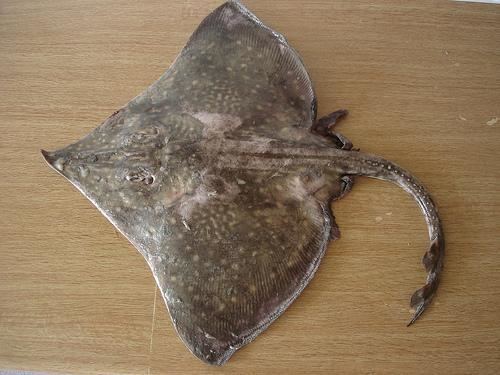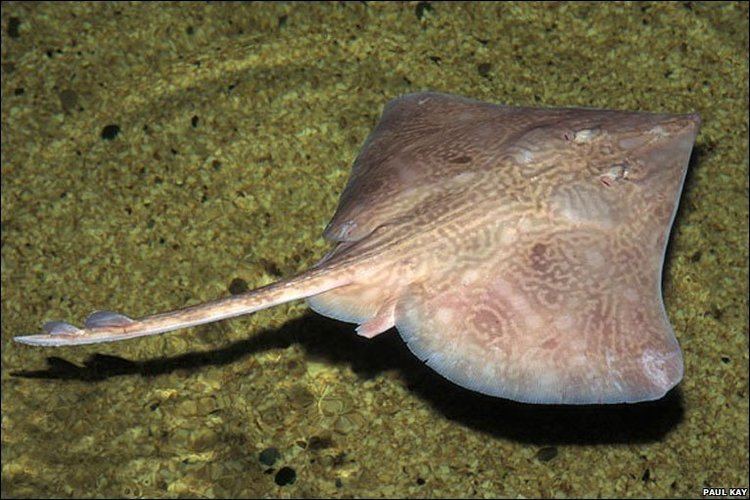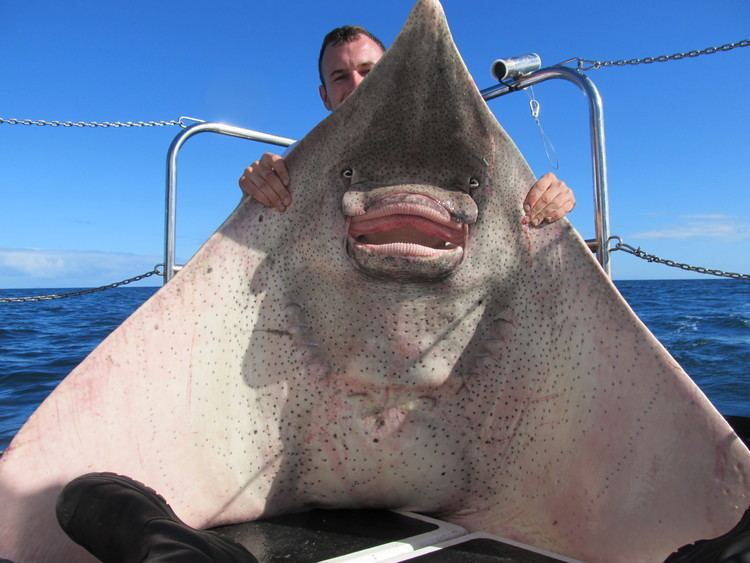Superorder Batoidea Family Rajidae Scientific name Dipturus batis Rank Species | Subclass Elasmobranchii Genus Dipturus Higher classification Dipturus | |
 | ||
Similar Skate, Dipturus, Batoids, Thornback ray, Raja montagui | ||
Common skate fishing in ireland series 1 episode 12
The common skate or blue skate (Dipturus batis, syn. Raja batis) is the largest skate in the world attaining a length of up to 2.85 m (9.4 ft). Historically, it was one of the most abundant skates in the northeast Atlantic Ocean and the Mediterranean Sea. Despite its name, today it appears to be absent from much of this range. Where previously abundant, fisheries directly targeted this skate and elsewhere it is caught incidentally as bycatch. The species was uplisted to Critically Endangered on the IUCN Red List in 2006 and it is protected within the EU.
Contents
- Common skate fishing in ireland series 1 episode 12
- Giant common skate fishing scotland april 2016
- Description
- Range habitat and ecology
- Growth and reproduction
- Egg case
- Diet
- Threatened status
- Taxonomy
- References
Research published in 2009 and 2010 suggests that the species should be split into two, the smaller southern D. cf. flossada (blue skate), and the larger northern D. cf. intermedia (flapper skate). Under this taxonomic arrangement, the name D. batis is discarded.

Giant common skate fishing scotland april 2016
Description

The common skate can reach up to 2.85 m (9.4 ft) in length, 2 m (6.6 ft) in width and 113 kg (249 lb) in weight, making it the largest skate in the world. Overall shape features a pointed snout and rhombic shape, with a row of spines or thorns along the tail. The top surface is generally coloured olive-grey to brown, often with a pattern of spots, and the underside is lighter blue-grey. It can be confused with several other skates in its range, such as D. nidarosiensis, D. oxyrinchus and Rostroraja alba.
Range, habitat and ecology

The common skate is native to the northeast Atlantic and Mediterranean Sea. Historically, the species ranged from Iceland and northern Norway to Madeira and northern Morocco. It is a bottom dwelling species mainly found at depths of 100–200 m (330–660 ft), but it can occur as shallow as 30 m (98 ft) and as deep as 1,000 m (3,300 ft). They are found in those depths at the waters off northwestern Scotland and in Celtic Sea, and along the edge of the continental shelf. At the start of the twentieth century common skates had a wide range around the British Isles. Now their population and range is severely depleted and fragmented, with disappearances being reported on several places.
Growth and reproduction

It is estimated that the common skate can reach an age of 50–100 years and maturity is reached when about 11 years old. Males are mature at a length of 1.25 m (4.1 ft) and females, where not yet determined for certain, are estimated to reach it at about 1.5 m (4.9 ft). For every male common skate there is approximately one female common skate, so the sex ratio is 1:1, but this can vary depending on geography and season. When hatching, juveniles measure up to 22.3 cm (8.8 in) long. Once it has reached sexual maturity, they will only reproduce every other year. They mate in the spring and during the summer females lay approximately 40 egg cases in sandy or muddy flats. The eggs develop for 2–5 months before hatching.
Egg case
Egg cases measure up to 25 cm (10 in) long, excluding the horns, and 15 cm (6 in) wide. They are covered in close-felted fibers and often washed up on the shore.
Egg case hunts have been done throughout the general distribution of the common skate. In the British Isles, egg cases were only found in northern Scotland and the north of Ireland. In the 19th and 20th centuries egg cases were seen along the entire British coastline in high numbers, but now they are only found in a few selective areas.
Diet
Like other skates, the common skate is a bottom feeder. Its diet consists of crustaceans, clams, oysters, snails, bristle worms, cephalopods, and small to medium-sized fish (such as sand eel, flatfish, monkfish, catsharks, spurdog, other skates). The size of the individual can affect its diet. Larger ones eat larger things like fish. The bigger the skate is the more food that will be needed to sustain its large body size. The activity level determines how much it eats; the more active it is the more it eats. The common skate does not only feed on creatures at the bottom of the ocean, as some do ascend to feed on mackerel, herring, and other pelagic fish, which are caugth by rapidly moving up from the seabed to grab the prey.
Threatened status
The common skate is listed as a Critically Endangered species by the IUCN. It is threatened both in the Atlantic Ocean and Mediterranean Sea. It has both been targeted directly and caught incidentally as bycatch. Due to the profitability of trawl fishing, it is likely that bycatch will remain a serious problem for the common skate. The species is extirpated in the Baltic Sea. Remaining strongholds are off western Scotland, in the Celtic Sea and along the coast of Norway.
Because the common skate is long-lived and slow to mature, it is difficult for it to repopulate quickly. Coupled with overfishing, this means that the common skate's population has drastically decreased and it is likely it will disappear entirely unless more is done to preserve it. It is strictly protected within the EU, making it illegal for commercial fishers to actively fish for it or keep it if accidentally landed. Like other elasmobranchs, it is believed to have a good chance of surviving if released after being caught.
Taxonomy
Research published in 2009 and 2010 found that there are distinct genetic and morphological differences within the common skate as traditionally defined, leading to the suggestion of splitting it into two species: The smaller (up to about 1.45 m or 4.8 ft in length) southern D. cf. flossada (blue skate), and the larger and slower-growing northern D. cf. intermedia (flapper skate). Under this taxonomic arrangement, the name D. batis is discarded. Based on molecular phylogenetics, D. cf. intermedia is closer to D. oxyrinchus than D. cf. flossada.
The eyes of D. cf. intermedia are dark olive-green and those of D. cf. flossada are pale yellow. Additional differences between the two are found in the blotch on their wings, thorns on their tails and other morphometric features. Both are found at the British Isles, but D. cf. intermedia is the main species in the northern half (off Scotland and Northern Ireland), and D. cf. flossada is the main in the southwest (Celtic Sea) and at Rockall.
